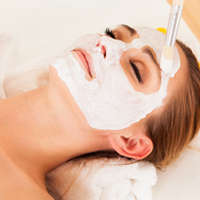 Although it may seem like all the contemporary movie and pop-stars are getting them, chemical peels are, by no means, a new thing. The ancient Egyptians used salts, oils and sour milk to improve the quality of their skin. The Greeks and Romans applied poultices of mustard and sulphur to encourage exfoliation. The practice has evolved and changed throughout history to the point that it still remains de rigeur amongst our modern day celebrities. But chemical peels are also commonly used by people who aren’t famous and don’t have millions of dollars in their bank accounts. Because of their popularity, more people are asking, “How do chemical peels work?” In this article, we’ll find out.
Although it may seem like all the contemporary movie and pop-stars are getting them, chemical peels are, by no means, a new thing. The ancient Egyptians used salts, oils and sour milk to improve the quality of their skin. The Greeks and Romans applied poultices of mustard and sulphur to encourage exfoliation. The practice has evolved and changed throughout history to the point that it still remains de rigeur amongst our modern day celebrities. But chemical peels are also commonly used by people who aren’t famous and don’t have millions of dollars in their bank accounts. Because of their popularity, more people are asking, “How do chemical peels work?” In this article, we’ll find out.
The Chemicals
A chemical peel is the application of an acid to the skin – normally the face. The acid breaks down the surface layers of the skin which can result in the reduction of wrinkles, acne, and discolouration. The type of acid used depends on the type of chemical peel that is being applied.
Three Types Of Chemical Peels
Superficial Peels
Superficial peels are quick, repeatable treatments of the top layer of skin that typically need little to no healing time. Superficial peels use acids such as glycolic, salicylic, kojic and malic to tighten up the skin, reduce fine lines and treat mild dark spots. Patients typically experience skin redness for up to an hour, tightness of the skin for a few hours and possibly some dryness over the next few days. The top layer of dead skin is sloughed off and collagen growth is stimulated.
Medium Peels
Medium peels are usually repeated every six months to a year and affect the top and middle layers of the skin. Recovery time can be up to a week which requires regular treatment with ointments. It can take up to six weeks for the skin to appear normal again. Medium peels use low concentrations of trichloroacetic acid and are used to treat skin with sun spots, acne scars and dark circles under the eyes.
Deep Peels
Deep peels are typically one-off treatments that affect deep layers of the skin. They may require a local anesthetic and sedatives. Swelling can last for a couple of weeks while redness of the skin can last for up to three months. High concentrations of trichloroacetic acid are used to treat serious skin problems such as scarring, sun damage and baggy skin.
 Leeza has been operating a hair removal business since 1987, starting with electrolysis services and then evolving to laser hair removal and laser skin treatments. Being aware of the many different types of laser hair removal technologies available, her method of choosing a successful product was to personally undergo the procedure herself...
Leeza has been operating a hair removal business since 1987, starting with electrolysis services and then evolving to laser hair removal and laser skin treatments. Being aware of the many different types of laser hair removal technologies available, her method of choosing a successful product was to personally undergo the procedure herself...